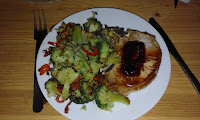The Vinaigrette
I was first introduced to these by a host family in France, who would whip up a little balsamic vinaigrette every night for the salad course. Since then, I've learned that you can build an enormous range of flavors from the basic combination of acid and oil that is a vinaigrette. These are best made right before you use them. If you use a lightweight vegetable oil they may keep in the refrigerator for a day or two, but many oils will thicken up when cold and create an unpleasant texture. If you are adding dried herbs, make them before you start the rest of the meal prep so that they have a little time to activate the flavor of the herbs.You can make vinaigrettes in a cup and whisk with a fork right before serving, but I like to keep a few clean jars (nutella or jam size) around. Just toss the ingredients in and give it a good shake to mix.
Classic Balsamic Vinaigrette:
1/4 cup balsamic vinegar1/4 cup extra-virgin olive oil
pinch of sea salt
pinch of fresh-ground pepper
drop of dijon mustard
(increase amounts as needed for multiple people)
This is the classic recipe my host family used, and works well on salads with strong flavors (bitter greens, spicy peppers or meats, sharp cheeses). If I want to add some variety I will include 1/4 teaspoon basil or rosemary to the mix.
Apple Cider Vinaigrette:
 |
1/3 cup olive oil
pinch each of salt, pepper, sugar (or a few drops of honey)
(increase amounts as needed for multiple people)
This goes well with a combination of strong, fruity flavors, such as field greens with granny smith apples, dried cranberries, and sharp cheddar cheese. It is even more delicious with some dried rosemary, but let it steep a few minutes before serving to bring the flavor out.
Red/White Wine Vinaigrette
1/3 cup wine vinager
1/3 cup lightly flavored salad oil (light olive oil, canola, etc.)
pinch of salt and pepper
(increase amounts as needed for multiple people)
This makes a lightly flavored base that will work well with added flavorings like fresh or dried herbs, fruit juice, etc.
Avocado Vinaigrette
1/3 cup mashed very ripe avocado1/3 cup white wine vinegar or rice vinegar
pinch of salt
(increase amounts as needed for multiple people)
Spice it up some chopped cilantro, and a few drops of lime juice (a little goes a long way!) Does not store well, but makes a delicious, creamy, nutritious dressing for taco salad or something with grilled peppers and tomatoes.
Bacon Vinaigrette
1/3 cup balsamic or red wine vinegar1/3 cup bacon drippings, still warm (or 2 tablespoons drippings with salad oil to make up the rest of the 1/3 cup, plus some bacon crumbles)
pinch of fresh-ground pepper
Eat this on a salad of fresh spinach, gouda cheese, bacon crumbles, candied nuts, and sliced strawberries, and you will never put up with an overpriced restaurant salad again. If you don't have the candied nuts, try adding a few drops of maple syrup to the vinaigrette. Your arteries might not thank me, but your tastebuds will!
****
Essentially, you mix some form of vinegar half and half with an oil or fat, add a few spices, and mix well to emulsify. It should be easy to come up with your own combinations!
****
THE CREAM DRESSINGS
Most of these are easy to make, and have the added bonus of surviving up to three days in the fridge for future salads and/or chip and veggie dip. The base is very simple: mix 2 parts sour cream to 1 part mayonnaise, add spices, then thin with milk until you have the consistency you like.Blue Cheese Dressing
1/2 cup sour cream 1/4 cup mayonnaise
1/4 cup mayonnaise1/3 cup blue cheese crumbles (or chopped Roquefort)
milk as needed to thin.
One of the recipes that will have you swearing off store-bought forever. It doesn't have to sit; you can toss it together right before you eat. Blue cheeses go really well with sweet, so salads with chopped apples, pears, and berries will all love this dressing. It also makes a great dip for pizza, chips, pretzels, etc.
Creamy Dill Dressing
1/2 cup sour cream1/4 cup mayonnaise
1/3 cup chopped fresh dill (or 2-3 tablespoons dried, but let dressing sit for at least 20 minutes to develop flavor)
milk as needed to thin
Also excellent for a veggie dip
Homemade Ranch
1/2 cup sour cream1/2 cup mayonnaise
1/4 tsp garlic powder
1/4 tsp onion powder
1/2 tsp dried dill
1/4 tsp dried chives
1/2 tsp dried parsley
pinch salt, pepper
milk or buttermilk to thin as needed
This one does have a time limit; after more than 12 hours or so the garlic gets really potent, and by the second day it is overwhelming. You want to make it about 20-30 minutes before eating to let the flavors blend, and finish the batch the same day. Luckily, ranch goes with everything!
TOMATO KETCHUP DRESSINGS
Thousand Island Dressing
1/2 cup mayonnaise1/4 cup sour cream
1/4-1/3 cup tomato ketchup (to taste)
1/4 cup sweet pickle relish
salt, pepper to taste
milk to thin, as needed
French Dressing
1/2 cup olive or salad oil1/3 cup ketchup
1/4 cup white wine vinegar or rice vinegar
1/2 teaspoon smoked paprika
1/2 teaspoon onion powder
1-2 teaspoon sugar, or more to taste
To make this Russian dressing, substitute mayonnaise for the olive oil, and add 1 teaspoon horseradish, a dash of hot sauce, and a dash of Worcestershire sauce.





































